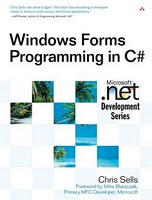Everything changes in the Microsoft .NET Framework and the C# language, including the creation of graphical user interfaces (GUIs). Windows Forms Programming in C# explains the Windows Forms (WinForms) environment to programmers who have some experience with .NET programming, and in the process (thanks to a clear and deliberate expository style) reveals a lot about .NET to less experienced developers.
The overall effect is that almost every reader comes away with better knowledge of .NET, not just its user-interface libraries and behaviors. Author Chris Sells takes care to balance code samples with explanatory text, meaning that most chapters take on a characteristic "code, explanation, effect" style (in which "effect" is usually documented with a screen shot). This approach is effective, and serves both to answer "How do I..." questions and inspire "I should give that a try!" exploration.
Once in a while, callouts will link two or more screen shots with a sample of code, graphically illustrating how code affects the appearance of a form and how it's represented in the Visual Studio development environment. On top of his clear teaching style, Sells calls attention to workarounds for shortcomings in the .NET environment (particularly where similar limitations don't exist in Microsoft Foundation Classes), helping to improve programmer productivity in the growing .NET environment.
My Facebook
Thursday, December 31, 2009
Subscribe to:
Post Comments (Atom)


0 comments:
Post a Comment